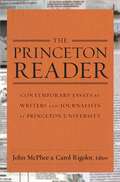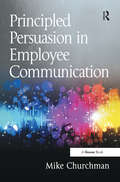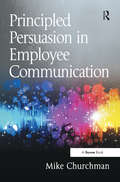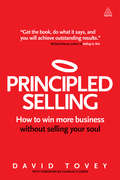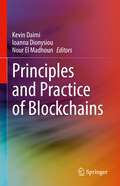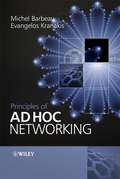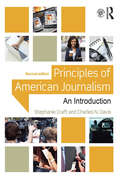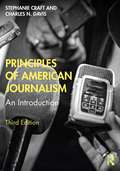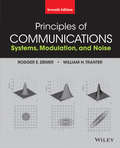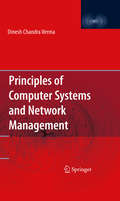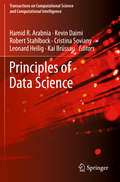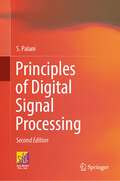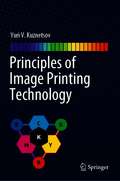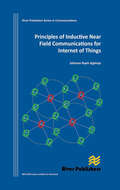- Table View
- List View
The Princeton Reader: Contemporary Essays by Writers and Journalists at Princeton University
by John McPhee & Carol RigolotFrom a Swedish hotel made of ice to the enigma of UFOs, from a tragedy on Lake Minnetonka to the gold mine of cyberpornography, The Princeton Reader brings together more than 90 favorite essays by 75 distinguished writers. This collection of nonfiction pieces by journalists who have held the Ferris/McGraw/Robbins professorships at Princeton University offers a feast of ideas, emotions, and experiences--political and personal, light-hearted and comic, serious and controversial--for anyone to dip into, contemplate, and enjoy.The volume includes a plethora of topics from the environment, terrorism, education, sports, politics, and music to profiles of memorable figures and riveting stories of survival. These important essays reflect the high-quality work found in today's major newspapers, magazines, broadcast media, and websites. The book's contributors include such outstanding writers as Ken Armstrong of the Seattle Times; Jill Abramson, Jim Dwyer, and Walt Bogdanich of the New York Times; Evan Thomas of Newsweek; Joel Achenbach and Marc Fisher of the Washington Post; Nancy Gibbs of Time; and Jane Mayer, John McPhee, John Seabrook, and Alex Ross of the New Yorker.The perfect collection for anyone who enjoys compelling narratives, The Princeton Reader contains a depth and breadth of nonfiction that will inspire, provoke, and endure.
The Princeton Reader: Contemporary Essays by Writers and Journalists at Princeton University
by John McPhee Carol RigolotFrom a Swedish hotel made of ice to the enigma of UFOs, from a tragedy on Lake Minnetonka to the gold mine of cyberpornography, The Princeton Reader brings together more than 90 favorite essays by 75 distinguished writers. This collection of nonfiction pieces by journalists who have held the Ferris/McGraw/Robbins professorships at Princeton University offers a feast of ideas, emotions, and experiences--political and personal, light-hearted and comic, serious and controversial--for anyone to dip into, contemplate, and enjoy.The volume includes a plethora of topics from the environment, terrorism, education, sports, politics, and music to profiles of memorable figures and riveting stories of survival. These important essays reflect the high-quality work found in today's major newspapers, magazines, broadcast media, and websites. The book's contributors include such outstanding writers as Ken Armstrong of the Seattle Times; Jill Abramson, Jim Dwyer, and Walt Bogdanich of the New York Times; Evan Thomas of Newsweek; Joel Achenbach and Marc Fisher of the Washington Post; Nancy Gibbs of Time; and Jane Mayer, John McPhee, John Seabrook, and Alex Ross of the New Yorker.The perfect collection for anyone who enjoys compelling narratives, The Princeton Reader contains a depth and breadth of nonfiction that will inspire, provoke, and endure.
Principled Persuasion in Employee Communication
by Mike ChurchmanPrincipled Persuasion in Employee Communication highlights a new but significant dilemma for organisational leaders. Will they continue on the same track that, since the nineteenth century, has led them to exert increasing control over their employees? Or will they take another path, one that leads towards a new type of working environment where the culture encourages freedom of communication and movement? This book argues for an approach to employee communication that sets out to liberate employees from the stifling constraints that organisations continue to impose on them. Principled Persuasion is so-called because it uses persuasive techniques, based on clear principles, to create new, forward-looking organisational cultures. It sets out to increase employee happiness and minimise the harms done to employees at work. It grounds itself on a strong ethical base composed of fundamental, universal principles. It introduces a new approach to the use of language, not only calling for more clarity and meaning in organisational communication, but also for a more conscious use of rhetorical techniques to change vocabulary, metaphors and internal dialogue for the better. Make no mistake, most organisations have totally underrated the strategic importance of employee communication. Principled Persuaders understand that the key to dealing with the unpredictable events about to unfold in the twenty-first century will be a new way of communicating with the workforce. The flexibility, adaptability and innovation that will be needed to survive and prosper in coming decades can only be achieved by liberating employees, not imprisoning them further in established systems and processes.
Principled Persuasion in Employee Communication
by Mike ChurchmanPrincipled Persuasion in Employee Communication highlights a new but significant dilemma for organisational leaders. Will they continue on the same track that, since the nineteenth century, has led them to exert increasing control over their employees? Or will they take another path, one that leads towards a new type of working environment where the culture encourages freedom of communication and movement? This book argues for an approach to employee communication that sets out to liberate employees from the stifling constraints that organisations continue to impose on them. Principled Persuasion is so-called because it uses persuasive techniques, based on clear principles, to create new, forward-looking organisational cultures. It sets out to increase employee happiness and minimise the harms done to employees at work. It grounds itself on a strong ethical base composed of fundamental, universal principles. It introduces a new approach to the use of language, not only calling for more clarity and meaning in organisational communication, but also for a more conscious use of rhetorical techniques to change vocabulary, metaphors and internal dialogue for the better. Make no mistake, most organisations have totally underrated the strategic importance of employee communication. Principled Persuaders understand that the key to dealing with the unpredictable events about to unfold in the twenty-first century will be a new way of communicating with the workforce. The flexibility, adaptability and innovation that will be needed to survive and prosper in coming decades can only be achieved by liberating employees, not imprisoning them further in established systems and processes.
Principled Persuasion in Employee Communication
by Mike ChurchmanPrincipled Persuasion in Employee Communication highlights a new but significant dilemma for organisational leaders. Will they continue on the same track that, since the nineteenth century, has led them to exert increasing control over their employees? Or will they take another path, one that leads towards a new type of working environment where the culture encourages freedom of communication and movement? This book argues for an approach to employee communication that sets out to liberate employees from the stifling constraints that organisations continue to impose on them. Principled Persuasion is so-called because it uses persuasive techniques, based on clear principles, to create new, forward-looking organisational cultures. It sets out to increase employee happiness and minimise the harms done to employees at work. It grounds itself on a strong ethical base composed of fundamental, universal principles. It introduces a new approach to the use of language, not only calling for more clarity and meaning in organisational communication, but also for a more conscious use of rhetorical techniques to change vocabulary, metaphors and internal dialogue for the better. Make no mistake, most organisations have totally underrated the strategic importance of employee communication. Principled Persuaders understand that the key to dealing with the unpredictable events about to unfold in the twenty-first century will be a new way of communicating with the workforce. The flexibility, adaptability and innovation that will be needed to survive and prosper in coming decades can only be achieved by liberating employees, not imprisoning them further in established systems and processes.
Principled Persuasion in Employee Communication (PDF)
by Mike ChurchmanPrincipled Persuasion in Employee Communication highlights a new but significant dilemma for organisational leaders. Will they continue on the same track that, since the nineteenth century, has led them to exert increasing control over their employees? Or will they take another path, one that leads towards a new type of working environment where the culture encourages freedom of communication and movement? This book argues for an approach to employee communication that sets out to liberate employees from the stifling constraints that organisations continue to impose on them. Principled Persuasion is so-called because it uses persuasive techniques, based on clear principles, to create new, forward-looking organisational cultures. It sets out to increase employee happiness and minimise the harms done to employees at work. It grounds itself on a strong ethical base composed of fundamental, universal principles. It introduces a new approach to the use of language, not only calling for more clarity and meaning in organisational communication, but also for a more conscious use of rhetorical techniques to change vocabulary, metaphors and internal dialogue for the better. Make no mistake, most organisations have totally underrated the strategic importance of employee communication. Principled Persuaders understand that the key to dealing with the unpredictable events about to unfold in the twenty-first century will be a new way of communicating with the workforce. The flexibility, adaptability and innovation that will be needed to survive and prosper in coming decades can only be achieved by liberating employees, not imprisoning them further in established systems and processes.
Principled Selling: How to Win More Business Without Selling Your Soul (Kogan Page Ser.)
by David ToveyBecause buyer behaviour has changed and buyers now trust social media and personal recommendations more than salespeople, companies need to respond to this new reality to acquire customers. Principled Selling discusses the skills and behaviours needed to win customers, build relationships and retain existing ones. It offers a different, more effective approach based on the premise that if you want more sales, stop 'selling' and focus on building long-term, profitable relationships. Readers will learn to avoid cold calling and generate meetings; develop relationships built on trust to maintain customer loyalty; sell services in ways clients appreciate; sustain long-term sales growth and incorporate social media into an effective business development strategy.With a foreword from legendary sales expert and bestselling author Richard Denny, Principled Selling helps anyone involved in selling to align his or her techniques with customer expectations to get people to buy over and over again.
Principled Selling: How to Win More Business Without Selling Your Soul
by David ToveyBecause buyer behaviour has changed and buyers now trust social media and personal recommendations more than salespeople, companies need to respond to this new reality to acquire customers. Principled Selling discusses the skills and behaviours needed to win customers, build relationships and retain existing ones. It offers a different, more effective approach based on the premise that if you want more sales, stop 'selling' and focus on building long-term, profitable relationships. Readers will learn to avoid cold calling and generate meetings; develop relationships built on trust to maintain customer loyalty; sell services in ways clients appreciate; sustain long-term sales growth and incorporate social media into an effective business development strategy.With a foreword from legendary sales expert and bestselling author Richard Denny, Principled Selling helps anyone involved in selling to align his or her techniques with customer expectations to get people to buy over and over again.
Principles and Practice of Blockchains
by Kevin Daimi Ioanna Dionysiou Nour El MadhounThis book provides an essential compilation of relevant and cutting edge academic and industry work on key Blockchain topics. This book concentrates on a wide range of advances related to Blockchains which include, among others, Blockchain principles, architecture and concepts with emphasis on key and innovative theories, methodologies, schemes and technologies of Blockchain, Blockchain platforms and architecture, Blockchain protocols, sensors and devices for Blockchain, Blockchain foundations, and reliability analysis of Blockchain-based systems. Further, it provides a glimpse of future directions where cybersecurity applications are headed. The book is a rich collection of carefully selected and reviewed manuscripts written by diverse cybersecurity application experts in the listed fields and edited by prominent cybersecurity applications researchers and specialists.
Principles and Practice of Marketing (PDF)
by Jim BlytheWhen you think of marketing you may think of the adverts that pop up at the side of your screen or the billboards you see when you're out - all those moments in the day when somebody is trying to grab your attention and sell you something! Marketing is about advertising and communications in part, but it's also about many other things which all aim to create value for customers, from product research and innovation to after-care service and maintaining relationships. It's a rich and fascinating area of management waiting to be explored - so welcome to Marketing! Jim Blythe's Principles and Practice of Marketing will ease you into the complexities of Marketing to help you achieve success in your studies and get the best grade. It provides plenty of engaging real-life examples, including brands you know such as Netflix and PayPal - marketing is not just about products, but services too. Marketing changes as the world changes, and this textbook is here to help, keeping you up to speed on key topics such as digital technologies, globalization and being green The companion website offers a wealth of resources for both students and lecturers and is available at www. sagepub. co. uk/blythe3e. An electronic inspection copy is also available for instructors.
Principles and Practice of Marketing (PDF)
by Jim BlytheWhen you think of marketing you may think of the adverts that pop up at the side of your screen or the billboards you see when you're out - all those moments in the day when somebody is trying to grab your attention and sell you something! Marketing is about advertising and communications in part, but it's also about many other things which all aim to create value for customers, from product research and innovation to after-care service and maintaining relationships. It's a rich and fascinating area of management waiting to be explored - so welcome to Marketing! This friendly textbook will ease you into the complexities of Marketing to help you achieve success in your studies and get the best grade. It provides plenty of engaging real-life examples, including brands you know such as Netflix and PayPal - marketing is not just about products, but services too. Marketing changes as the world changes, and this textbook is here to help, keeping you up to speed on key topics such as digital technologies, globalization and being green. A supporting website includes lots of useful extra materials for your study such as videos and extra case studies to help make the text come alive - and more importantly, improve your chances of exam success and a career in marketing!.
Principles of Ad-hoc Networking
by Michel Barbeau Evangelos KranakisPrinciples of Ad Hoc Networking presents a systematic introduction to the fundamentals of ad hoc networks. An ad-hoc network is a small network, especially one with wireless or temporary plug-in connections. Typically, some of the network devices are part of the network only for the duration of a communications session or, in the case of mobile or portable devices, while in some close proximity to the rest of the network. These networks can range from small and static systems with constrained power resources to larger-scale dynamic and mobile environments. Wireless ad hoc networks facilitate numerous and diverse applications for establishing survivable dynamic systems in emergency and rescue operations, disaster relief and intelligent home settings. Principles of Ad Hoc Networking: Introduces the essential characteristics of ad hoc networks such as: physical layer, medium access control, Bluetooth discovery and network formation, wireless network programming and protocols. Explains the crucial components involved in ad-hoc networks in detail with numerous exercises to aid understanding. Offers key results and merges practical methodologies with mathematical considerations. Principles of Ad Hoc Networking will prove essential reading for graduate students in Computer Science, Electrical Engineering, Applied Mathematics and Physics as well as researchers in the field of ad hoc networking, professionals in wireless telecoms, and networking system developers. Check out www.scs.carleton.ca/~barbeau/pahn/index.htm for further reading, sample chapters, a bibliography and lecture slides!
Principles of American Journalism: An Introduction
by Stephanie Craft Charles N. DavisDesigned to engage, inspire and challenge students while laying out the fundamentals of the craft, Principles of American Journalism introduces readers to the core values of journalism and its singular role in a democracy. From the First Amendment to Facebook, the new and revised edition of this popular textbook provides a comprehensive exploration of the guiding principles of journalism and what makes it unique: the profession's ethical and legal foundations; its historical and modern precepts; the economic landscape of journalism; the relationships among journalism and other social institutions; the key issues and challenges that contemporary journalists face. Case studies, exercises, and an interactive companion website encourage critical thinking about journalism and its role in society, making students more mindful practitioners of journalism and more informed media consumers.
Principles of American Journalism: An Introduction
by Stephanie Craft Charles N. DavisDesigned to engage, inspire and challenge students while laying out the fundamentals of the craft, Principles of American Journalism introduces readers to the core values of journalism and its singular role in a democracy. From the First Amendment to Facebook, the new and revised edition of this popular textbook provides a comprehensive exploration of the guiding principles of journalism and what makes it unique: the profession's ethical and legal foundations; its historical and modern precepts; the economic landscape of journalism; the relationships among journalism and other social institutions; the key issues and challenges that contemporary journalists face. Case studies, exercises, and an interactive companion website encourage critical thinking about journalism and its role in society, making students more mindful practitioners of journalism and more informed media consumers.
Principles of American Journalism: An Introduction
by Stephanie Craft Charles N. DavisDesigned to engage, inspire, and challenge students while laying out the fundamentals of the craft, this textbook introduces readers to the core values of journalism and its singular role in a democracy. From the First Amendment to Facebook, this popular textbook – now in its third edition – provides a comprehensive exploration of the guiding principles of journalism and what makes it unique. Authors Stephanie Craft and Charles Davis cover the profession's ethical and legal foundations, its historical and modern precepts, the economic landscape of journalism, the relationships among journalism and other social institutions, and the key issues and challenges that contemporary journalists face. They also discuss the current ambiguities and transitions – economic and technological – occurring in the field, from nonprofit news sites to social media’s effects on journalism. Filled with relevant case studies, exercises, and discussion questions that encourage critical thinking about journalism and its role in society, this book helps students become better-informed media consumers as well as more mindful practitioners of journalism. The companion website features chapter-by-chapter flashcards, quizzes, and annotated weblinks for students and a separate instructor resource section that features sample test questions, PowerPoint slides, sample syllabi, and chapter-by-chapter activities and discussion questions.
Principles of American Journalism: An Introduction
by Stephanie Craft Charles N. DavisDesigned to engage, inspire, and challenge students while laying out the fundamentals of the craft, this textbook introduces readers to the core values of journalism and its singular role in a democracy. From the First Amendment to Facebook, this popular textbook – now in its third edition – provides a comprehensive exploration of the guiding principles of journalism and what makes it unique. Authors Stephanie Craft and Charles Davis cover the profession's ethical and legal foundations, its historical and modern precepts, the economic landscape of journalism, the relationships among journalism and other social institutions, and the key issues and challenges that contemporary journalists face. They also discuss the current ambiguities and transitions – economic and technological – occurring in the field, from nonprofit news sites to social media’s effects on journalism. Filled with relevant case studies, exercises, and discussion questions that encourage critical thinking about journalism and its role in society, this book helps students become better-informed media consumers as well as more mindful practitioners of journalism. The companion website features chapter-by-chapter flashcards, quizzes, and annotated weblinks for students and a separate instructor resource section that features sample test questions, PowerPoint slides, sample syllabi, and chapter-by-chapter activities and discussion questions.
Principles of Broadband Switching and Networking (Wiley Series in Telecommunications and Signal Processing #32)
by Soung C. Liew Tony T. LeeAn authoritative introduction to the roles of switching and transmission in broadband integrated services networks Principles of Broadband Switching and Networking explains the design and analysis of switch architectures suitable for broadband integrated services networks, emphasizing packet-switched interconnection networks with distributed routing algorithms. The text examines the mathematical properties of these networks, rather than specific implementation technologies. Although the pedagogical explanations in this book are in the context of switches, many of the fundamental principles are relevant to other communication networks with regular topologies. After explaining the concept of the modern broadband integrated services network and why it is necessary in today’s society, the book moves on to basic switch design principles, discussing two types of circuit switch design—space domain and time domain—and packet switch design. Throughput improvements are illustrated by some switch design variations such as Speedup principle, Channel-Grouping principle, Knockout principle, and Dilation principle. Moving seamlessly into advanced switch design principles, the book covers switch scalability, switch design for multicasting, and path switching. Then the focus moves to broadband communications networks that make use of such switches. Readers receive a detailed introduction on how to allocate network resources and control traffic to satisfy the quality of service requirements of network users and to maximize network usage. As an epilogue, the text shows how transmission noise and packet contention have similar characteristics and can be tamed by comparable means to achieve reliable communication. Principles of Broadband Switching and Networking is written for senior undergraduate and first-year postgraduate students with a solid background in probability theory.
Principles of Communications
by Rodger E. Ziemer William H. TranterKeeping up to date with the most current technologies in the field is essential for all effective electrical and computer engineers. The updated 7th edition of Principles of Communications presents the reader with more in-chapter examples, providing for a more supportive framework for learning. Readers are exposed to digital data transmission techniques earlier in the book, so they can appreciate the characteristics of digital communication systems prior to learning about probability and stochastic processes. They will also find expanded forward error correction code examples, and additional MATLAB problems.
Principles of Computer Systems and Network Management
by Dinesh Chandra VermaSystems Management is emerging as the predominant area for computer science in the enterprise, with studies showing that the bulk (up to 80%) of an enterprise IT budget is spent on management/operational issues and is the largest piece of the expenditure. This textbook provides an overview of the field of computer systems and network management. Systems management courses are being taught in different graduate and undergraduate computer science programs, but there are no good books with a comprehensive overview of the subject. This text book will provide content appropriate for either an undergraduate course (junior or senior year) or a graduate course in systems management.
Principles of Data Science (Transactions on Computational Science and Computational Intelligence)
by Hamid R. Arabnia Robert Stahlbock Kevin Daimi Cristina Soviany Leonard Heilig Kai BrüssauThis book provides readers with a thorough understanding of various research areas within the field of data science. The book introduces readers to various techniques for data acquisition, extraction, and cleaning, data summarizing and modeling, data analysis and communication techniques, data science tools, deep learning, and various data science applications. Researchers can extract and conclude various future ideas and topics that could result in potential publications or thesis. Furthermore, this book contributes to Data Scientists’ preparation and to enhancing their knowledge of the field. The book provides a rich collection of manuscripts in highly regarded data science topics, edited by professors with long experience in the field of data science.Introduces various techniques, methods, and algorithms adopted by Data Science expertsProvides a detailed explanation of data science perceptions, reinforced by practical examplesPresents a road map of future trends suitable for innovative data science research and practice
Principles of Digital Signal Processing: 2nd Edition
by S. PalaniThis book provides a comprehensive introduction to all major topics in digital signal processing (DSP). The book is designed to serve as a textbook for courses offered to undergraduate students enrolled in electrical, electronics, and communication engineering disciplines. The text is augmented with many illustrative examples for easy understanding of the topics covered. Every chapter contains several numerical problems with answers followed by question-and-answer type assignments. The detailed coverage and pedagogical tools make this an ideal textbook for students and researchers enrolled in electrical engineering and related programs.
Principles of Image Printing Technology
by Yuri V. KuznetsovPrinciples of Image Printing Technology is a unique review of technology use in the printing industry since the time of the medieval engravers and busy newsroom typesetters. It provides a historical review of the advancement of technology and describes in-depth both technical fundamentals and industrial procedures. Intended primarily for students in graphic communications programs, this book includes all the necessary background for understanding printing technology. In addition, by providing findings from basic research studies and industrial processes that have been omitted elsewhere in published volumes, it offers a useful guide to researchers and professionals in the printing industry.
Principles of Inductive Near Field Communications for Internet of Things
by Johnson I. AgbinyaNear field communication devices and the emerging field of Internet of things require efficient short range communication techniques. Classical telecommunication theory however has so far focused on radiating electromagnetic signals which is more suited to terrestrial communication systems. Over the last decade however considerable research and applications of inductive methods have emerged as innovative approaches for secure short range communications by changing the paradigm of an established model of electromagnetic communications. We have witnessed the emergence of embedded inductive medical devices, magneto-inductive waveguides, inductive pots and cooking devices, magneto-inductive sensors, wireless power transfer, inductive hearing aids and the emerging inductive point-to-point communication specifically termed near-field communication (NFC) as used in mobile phones and payment cards to name a few. While there exist a large set of distributed methods and algorithms detailing the design and performances of such applications, a significant gap is observed as a lack of detailed collection of the methods in one place which could be easily understood and used quickly by someone seeking to apply the methods.In this book this missing gap is filled with the required details and the theory of near field communication systems including both the radiating and reactive (energy coupling) near-field systems in addition to the well known far field radiation techniques. The book details the fundamental expressions and design methods which facilitate the creation of near field devices and equipment including embedded biomedical implants. The book contains recent advances in inductive communications, performance, limitations and a collection of applications. It also lays a strong foundation for the application of inductive methods for creating Internet of Things systems.
Principles of Inductive Near Field Communications for Internet of Things
by Johnson I. AgbinyaNear field communication devices and the emerging field of Internet of things require efficient short range communication techniques. Classical telecommunication theory however has so far focused on radiating electromagnetic signals which is more suited to terrestrial communication systems. Over the last decade however considerable research and applications of inductive methods have emerged as innovative approaches for secure short range communications by changing the paradigm of an established model of electromagnetic communications. We have witnessed the emergence of embedded inductive medical devices, magneto-inductive waveguides, inductive pots and cooking devices, magneto-inductive sensors, wireless power transfer, inductive hearing aids and the emerging inductive point-to-point communication specifically termed near-field communication (NFC) as used in mobile phones and payment cards to name a few. While there exist a large set of distributed methods and algorithms detailing the design and performances of such applications, a significant gap is observed as a lack of detailed collection of the methods in one place which could be easily understood and used quickly by someone seeking to apply the methods.In this book this missing gap is filled with the required details and the theory of near field communication systems including both the radiating and reactive (energy coupling) near-field systems in addition to the well known far field radiation techniques. The book details the fundamental expressions and design methods which facilitate the creation of near field devices and equipment including embedded biomedical implants. The book contains recent advances in inductive communications, performance, limitations and a collection of applications. It also lays a strong foundation for the application of inductive methods for creating Internet of Things systems.
Principles of Integrated Airborne Avionics (Springer Aerospace Technology)
by Igor Victorovich Avtin Vladimir Ivanovich Baburov Boris Victorovich Ponomarenko Yuri Grigorievich ShatrakovThis book discusses the principles, approaches, concepts and development programs for integrated aircraft avionics. The functional tasks of integrated on-board radio electronic equipment (avionics) of navigation, landing, data exchange and air traffic control are formulated that meet the modern requirements of civil and military aviation, and the principles of avionics integration are proposed. The modern approaches to the joint processing of information in navigation and landing complexes are analyzed. Algorithms of multichannel information processing in integrated avionics are considered, and examples of its implementation are presented. This book is intended for scientists and professionals in the field of aviation equipment, students and graduate students of relevant specialties.
